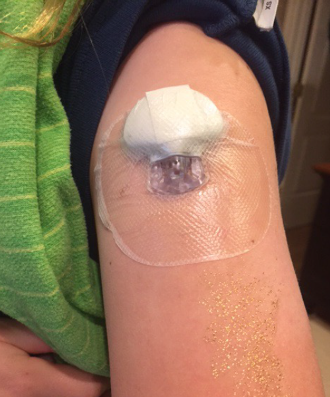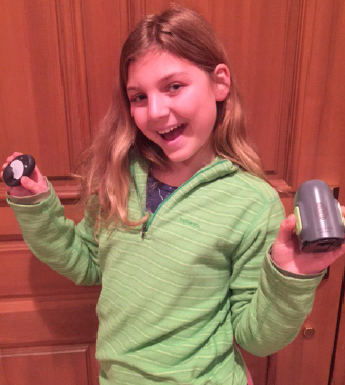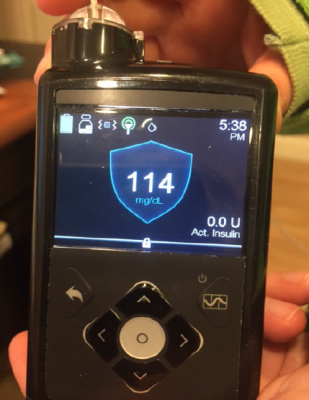Welcome to our new blog series, Diary of an Artificial Pancreas, written by 12-year-old Jamie Kurtzig. Each month, she will share her day-to-day experiences living with the Medtronic MiniMed 670G closed-loop system, or Artificial Pancreas. Jamie, diagnosed with type 1 diabetes (T1D) at 19-months old, participated in a clinical trial for this system with Stanford University in the summer of 2016. She was able to keep the system and has been living with it ever since.
By Jamie Kurtzig
January 1, 2017
I am in Hawaii right now and everything has been amazing. There were no problems with the Artificial Pancreas 670G on the trip or at the airport. I just NEVER go through security machines – I get a hand pat every time, but I did this even before I was loaned the 670G for the clinical trial. However, I spent a lot of time out of auto mode so far on this trip because I was swimming so much. The pump is not water-proof, so whenever I swim, I disconnect. I did not disconnect for swimming with my old Animas pump. After the 670G pump has been disconnected for a while (while I was swimming, playing, and splashing), it not only sings/alarms loudly and continuously, but it also
kicks you out of auto mode. It is usually not that hard to get back in. Just be sure you have towels to wrap up your pump so it does not drive beach or pool goers crazy with all of its ringing when disconnected. Other than this small inconvenience, my trip has been really fun. I am looking forward to 2017!
January 2, 2017
Today, I flew home from Hawaii! I love Hawaii, so it was really hard for me to leave. During our 5-hour plane fight home, the pump stopped delivering insulin to me in the third hour of the flight. It kept alarming, saying that there was a stuck button. Sure enough, when I tried to use the pump, the buttons I tried to press didn’t react. It was like the main button had been sucked in and was stuck in the push position. It started alarming and I got really worried that I might disturb other people on the flight or go really high since no insulin was being delivered while this was happening. Finally, we disconnected it and wrapped it up and sat on it to hide the LOUD and constant alarms on the plane! I do not know why we did not just remove the battery to stop the loud alarms, but we did not think of that at the time! Anyway, thank goodness I was at BG 124 with no active insulin (on board) when all of this started so it turned out OK that I had no insulin for a while. We always travel with vials and needles just in case something weird like this happens, so we had a back up plan that we did not have to use. About 2 hours later, when we were driving in our car to our house, the pump suddenly lit back up and displayed a more normal looking screen. The button was no longer stuck and we got back in auto mode that night when we arrived home. Before it righted itself, we did call the help line for clinical trial patients. They said we would need to trade this pump in and get a new one. They wanted to study it more closely to see what happened. Fast forward a few days…. Medtronic said that our pump had reacted negatively to the pressure change on the airplane and one other study participant had had this happen as well. They are now aware of the problem and are working on it. I think it is really good to know that pumps can react negatively to cabin pressure change – please always have a back up plan when travelling! Thank you Medtronic for looking into this! I am flying again in late February and I will keep you posted how it goes!
January 3, 2017
We’ve been home from vacation for not even a day and our power was completely off for the whole day! I was so glad that my pump and important equipment are battery operated! Today turned out to be a really relaxing day, free from pump alarms and problems. It all worked out beautifully and I did almost no interventions. We played board games by candlelight and sat by the fire and had quesadillas, scrambled eggs, and chili with cheese from our gas stove top. It was a great day.
January 4, 2017
Oh Boy! We just realized that we left my sensor charger and inserter in Hawaii by accident! Thank goodness my grandma found it and Fed Exed it back here to us today when she found them! They will be here in 2 days! Thank goodness I put in a new 7 day sensor 2 days ago so hopefully it will last another few days (they are supposed to be good for 7 days, though I almost always have to replace mine on day 6 it seems – it just gets weird and less accurate with more alarms around then for me). Fingers crossed it will make it. You only get one of each of these necessary items during the clinical trial period and Medtronic will not offer you another set unless you lose it or it malfunctions. Take good care of these things if you get your 670G system – do not lose track of them. The sensor charger is so small and we’ve never had one before since the Dexcom CGM does not need one (you just get a new gray transmitter every few months).
January 10, 2017
Today was my quarterly visit for the “continuation phase” of my clinical trial. I received a replacement pump finally today because of the stuck button air plane pressure problem. I hope that my next plane flight works out well. My mom had really wanted to get a replacement sooner, but you need to pick up clinical trial supplies in PERSON! We did not feel like driving to Stanford immediately upon getting home from vacation so we just waited until today to pick it up in person. I got my quarterly blood draw (I was nervous, but everyone helped me a lot) because it is necessary for the study protocol (one of the only downsides of being in this study). I also picked up the new supplies for me to use this quarter. They told me that I needed to delete the connection between the 2 bg meters and my old pump because I didn’t need the meter to beam to the old pump anymore. I also disconnected the sensor from the transmitter and the pump so that the sensor would stop sending the old pump readings. Then, I had to pair the new pump to the two existing meters and the existing sensor. My mom and dad were so excited to be getting the new 670G, but we learned that when you get a new 670G pump, it takes 48 hours from midnight that day until you can get into auto mode. (We had forgotten about this fact from the beginning of our clinical trial!) The pump then learns about you and adjusts its basal rates during those 48 hours. I will let you know on Friday what happens on my first day back in auto mode! Mom and Dad were sooooo bummed with this news of 2 more sleep interrupted nights! We have gotten spoiled!
January 12, 2017
Wow! Back in auto mode – finally! I was overjoyed to see the blue shield of auto mode after 2 days of difficulty with the “normal” pump in manual mode. It was so nice to have the pump give the smart basal rate on its own and help keep my blood sugar more under control with less effort. I got pretty frustrated after 2 days of checking every few hours and making adjustments manually, but today was like heaven. I just love that feeling of seeing the blue shield after a long time out of auto mode. I had a great day and the fact that it was a Friday definitely helped make the day even better! The blue shield of auto mode on my new pump!
January 14, 2017
Today, I got another really cool new Device – the NIMA sensor. It is for people with celiac disease (an autoimmune disease which I also have and lots of people with T1D have too). It tests to see if there are less than 20 ppm (parts per million) of gluten in a particular food or drink item. 20 ppm or under is the amount of gluten that the doctors say are OK for people with celiac. We tested: a birthday cake from Whole Foods Bakery that said Gluten Free, corn tortilla chips that said Gluten Free on the packaging, corn tortilla chips from restaurants, Honey Nut Cheerios (one of my favorite breakfast cereals), crepes from the Marin Farmer’s Market that were advertised as gluten free, crab tacos from one of our favorite restaurants Willi’s Wine Bar in Santa Rosa, packaged corn tortillas that said Gluten Free on the package, gluten free buns from restaurants, and rotisserie chicken from the Farmers Market. See if you can guess which ones were gluten free – safe for people with celiac – under 20 ppm.
Answers:
Whole Foods bday cake – gluten free
Packaged Corn Tortilla chips that said Gluten Free – gluten free
Corn Tortilla chips from restaurants – NOT gluten free
Cheerios – gluten free
Crab tacos – gluten free
Crepes – advertised as gluten free – NOT gluten free
Gluten free buns from restaurants – NOT gluten free
Rotisserie Chicken from farmers market – NOT gluten free (must have had a gluten
sauce that they were not aware of)

The black triangle is the Nima and the packaged thing is the tester tube that slides into the sensor.
The test itself takes about 5 minutes so you can learn quickly if it is safe to eat or not. Here is a photo of what the Nima looks like! The happy face is when a food item has under 20 ppm gluten. It displays a wheat symbol and says GLUTEN FOUND when it is not safe. The sample size for the food is pea sized. It has been really interesting to be able to test all this food that we were never really sure if they were safe enough for me. The cross contamination is always a big wild card. What we noticed is that bread products that are not produced in a dedicated gluten free bakery were not typically gluten free due to cross contamination. Also, a lot of marinades and sauces are not gluten free so I try to ask for no sauce. Overall, everything that we are learning is fascinating. I can’t wait to keep experimenting with Nima!


